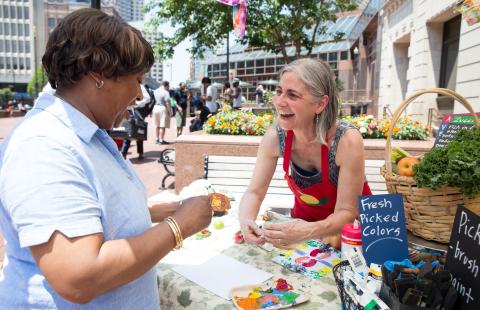What were the specific goals of this creative economy project? Describe the community development challenge or opportunity that your project was designed to address:
Art on the Steets has 3 major goals: Engaging the downtown community, particularly the corporate community who make up a large share of our donors, with the arts; promote the connection between the arts and health through interactive arts experiences; and downtown activation through the arts.
Our project was designed to address the challenge that our community has so many who come here during the day for work, but are completely disengaged with the city and do not know that there is a world class art museum or Tony-award winning theater across the street from their office (literally!). Art on the Streets was designed to capture the natural traffic that ventures out for lunch, but also to encourage people to come out onto the streets and experience the city.
Who was involved in this project and what did they do? (be sure to include the partners from outside of the creative sector and how local voices were included):
Aetna - funder and planning partner
State House Square - venue and promotional support
Hartford Business Improvement District - venue and promotional support
Artists - designing and implementing engaging arts activities
City of Hartford - permitting for year 1
How does this project relate to a larger community development strategy?
Art on the Streets is at the root of the Greater Hartford Arts Council's mission and vision.
The mission of the Arts Council is to inspire all people to participate and invest in the arts. Through quick, interactive arts experiences during Art on the Streets, people who may not have engaged in a creative act that day get an opportunity to slow down and experience something outside of the monotony of their day. Many people tell the artists that these experiences change their attitude or relieve the stress they are feeling. This experience encourages them to seek out additional arts experiences in the City and to continue to explore their creative expressions as an outlet.
The vision of the Arts Council is to create a vibrant, thriving community that is united by art. The vibrancy of downtown can be felt through the energy radiating from Art on the Streets, but not only is it felt that day. That energy is remembered by people who come back year after year excited to engage in the activities and it has rippled into additional arts experiences across downtown outside of Arts Council organized events. Salsa Socials, author events, and a spin off of Art on the Streets called Poetry on the Streets can be found activating downtown in the spring, summer and fall.
What projects or places, if any, inspired your approach to this creative economy project?
Art on the Streets was originally inspired by classic street performers and buskers. Artists who practice street performance are seen in every major city, but had been lost to Hartford decades ago.
Also, in the 1970s a group of artists created a series known as Thursdays are a Work of Art. This series included avante garde street performances and art installations that would pop up downtown on Thursdays. Most of the installations were interactive and were intended to catch downtown workers and community members off guard. Individuals who have been in Hartford since the 1970s still talk about these performances and shared with Arts Council staff that they have seen nothing like it since the program ended after only 2 years. Art on the Streets, though rarely considered avante garde, is the first engagement of that kind since Thursdays are a Work of Art.
